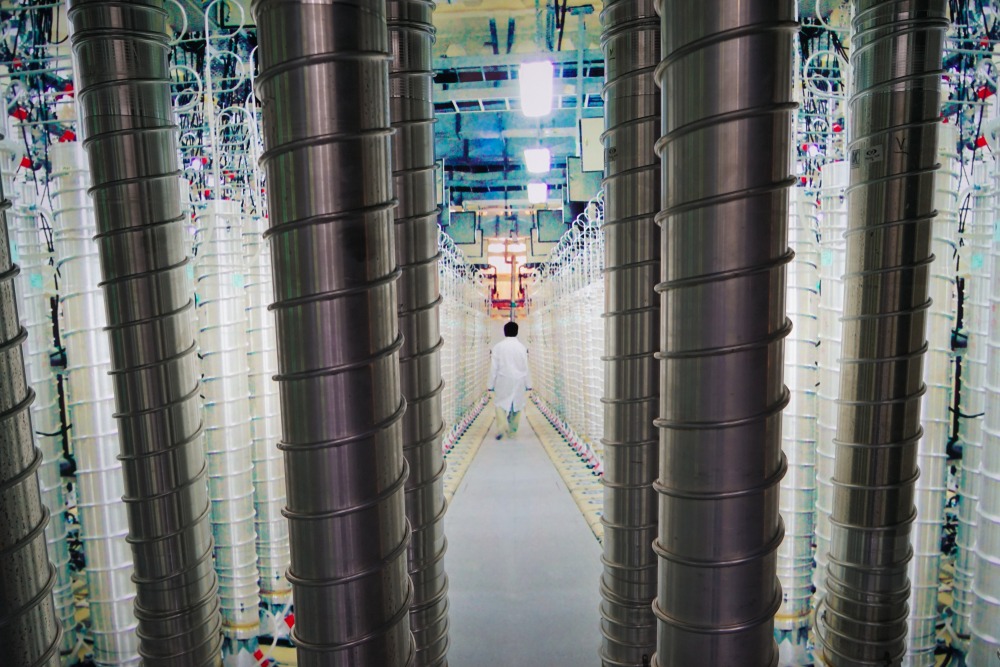IAEA: Iran accelerates production of near-weapons-grade uranium
At the end of November Tehran tripled the rate of production of 60%-enriched uranium, according to the U.N. watchdog.
(JNS)
Iran recently tripled its enrichment of uranium to 60%, reversing a slowdown earlier this year, the International Atomic Energy Agency reported on Tuesday.
Tehran has “increased its production of highly enriched uranium, reversing a previous output reduction from mid-2023,” said the U.N. watchdog, summarizing a confidential report sent to member states and obtained by Reuters.
Iran is enriching uranium up to 60% at the Pilot Fuel Enrichment Plant (PFEP) in Natanz and at the Fordow Fuel Enrichment Plant (FFEP), which is located deep in a mountain, according to the report.
Since mid-June, those plants had been enriching uranium to up to 60% at a rate of about 3 kilograms a month, the IAEA said.
“The agency confirms that, since the end of November 2023, the rate at which Iran has been producing uranium enriched up to 60% U-235 at these two facilities combined has increased to approximately 9 kg per month,” according to the IAEA report.
IAEA inspectors first observed a change in production at Fordow on Nov. 25, after which Iran said the modification was made three days earlier. Inspectors observed the increase at Natanz on Nov. 27. Both observations were verified in the past week.
According to Reuters, many diplomats believe the months-long slowdown was the result of secret talks between the United States and Iran that led to the release of U.S. citizens held in the Islamic Republic earlier this year.
Iran already has enough enough high-enriched uranium, if enriched further to 90%, to make three nuclear bombs, Reuters reported, citing the International Atomic Energy Agency’s theoretical definition.
The IAEA’s previous quarterly report on Iran showed Tehran had 121.6 kilograms (268 pounds) of uranium enriched to 60%. In May, the IAEA placed the Islamic Republic’s stockpile of 60% enriched uranium at just over 114 kilograms (250 pounds) and in February at 87.5 kilograms (192 pounds).
Uranium enriched to 60% purity is just a short technical step away from 90%, considered weapons-grade.
Iran’s total enriched uranium stockpile was estimated at 3,795.5 kilograms (8,367.7 pounds) as of August 19, down by 949 kilograms from May.
The limit in the 2015 nuclear deal was set at 202.8 kilograms.
Also in September, AP reported that Iran was still attempting to stonewall IAEA officials by denying them visas, while the “de-designation of experienced agency inspectors” was also challenging the body’s monitoring work.
Moreover, the IAEA has since February 2021 reportedly been unable to access surveillance footage from declared nuclear sites, with the only recorded data as of June last year originating from cameras at a workshop in the Iranian city of Isfahan.
A month earlier, Israeli Prime Minister Benjamin Netanyahu slammed the emerging U.S.-Iran deal for the release of five U.S. prisoners in exchange for Washington unfreezing billions of dollars in Iranian assets.
“Israel’s position is known: Arrangements that do not dismantle Iran’s nuclear infrastructure do not stop its nuclear program and only provide it with funds that go to terrorist elements sponsored by Iran,” said Netanyahu.
Israeli National Security Adviser Tzachi Hanegbi warned in September that Jerusalem will have no choice but to act if Iran enriches uranium above 60% purity.
“If Iran moves to enrich uranium above 60% and we identify it—and there is no possibility that we won’t, that the world would not recognize it—the result is that Israel would act out of necessity,” said Hanegbi. “There would be no choice.”
Centrifuges at the Iran nuclear energy exhibition in the Islamic Revolution and Holy Defense Museum in Tehran, 2018. Credit: Maps/Shutterstock.
At the time, reports quoted an unnamed Israeli official as saying that Jerusalem did not consider the development as a trigger for military action “because Tehran didn’t amass any of the material at that level.”
Image: Centrifuges at the Iran nuclear energy exhibition in the Islamic Revolution and Holy Defense Museum in Tehran, 2018. Credit: Maps/Shutterstock.



